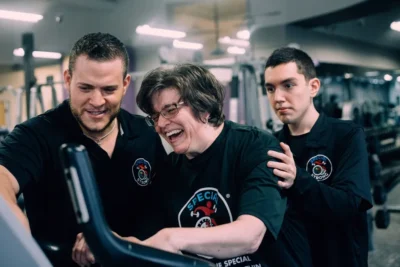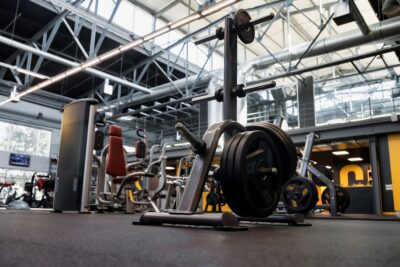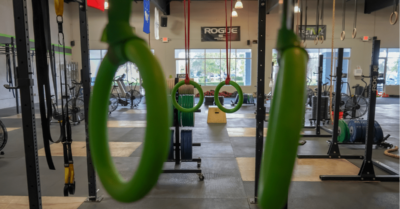Gym financing can be one of the biggest headaches in setting up a new fitness business. There are a lot of obstacles to jump over before you can experience success. The first part of starting a gym is creating a unique concept and defining your who and why. The next stage is to figure out how you’re going to finance your business, gym equipment, and growth.
If you need help finding your unique selling point and what makes your business special, you can find the full guide here.
Employee salaries, fitness equipment, and monthly rental fees all add up quickly. With ongoing and one-off costs to be paid in full, having a financial plan in place to grow from the beginning is very beneficial. In this article, we try to understand the ins and outs of gym financing and the options you have for funding to get your dream business off the ground.
Skip ahead to:
- How much does it cost to open a gym?
- What gym financing options are available?
- Leasing vs. buying
- 9 costs to consider in gym financing
How Much Does it Cost to Open a Gym?
When you’re trying to gauge how much something costs, no doubt this question is one of the first you need to ask. The problem with this is that the answer can be so different depending on your type of business, size, and future growth plans. The number can vary massively. But to give you an idea of what to expect, here are a few different options and the estimated startup costs to open them:
- Home gym for personal training clients – starting at $10,000
- Modest budget facility – starting at $50,000
- Mid-size gyms – between $200,000 and $400,000
- Mega-gyms with everything you could ever want – upwards of $1,000,000
These numbers are just looking at startup costs and what you need to invest to get off the ground. You could open a small cycling studio for $50,000, but even with smaller businesses, the costs can spiral. That’s why it’s important to have some financial cushioning so that you can handle any setbacks without derailing the whole business.
The initial cost of opening a gym is expensive, but the reason it can vary so much is that you may not need everything. Alongside one-off costs such as permits, licenses, and qualifications, there are also ongoing costs that you can factor into your budget. Your recurring or ongoing costs include monthly rental fees, employee wages, and gym equipment lease payment plans.
Read More: Expert Founder Tips From Todd Wadler
What Gym Financing Options are Available?
When it comes to gym financing, you have a few options available to get your funding. You may want to use one of these or a combination, depending on your business and situation. What works for someone might not work for another. But the first stage of securing any financing is creating a solid business plan of your vision, expertise, experience, and future growth plans. Understand how much you need to borrow and get your calculations correct and ready.
Bank Loan
One way to secure funding is by getting a business loan from the bank. To have a loan pre-approved by the bank or loan provider, you will need to show your business plan, identification documents, and anything else necessary for credit approval. The benefit of a bank loan is that it’s a secure form of financing. The downside is that it can be expensive because of high interest rates.
Personal Savings
If you have funds available, the least expensive way to finance your business is through your personal savings, as you won’t be paying any interest. The problem with this is that it’s a risk to finance your business solely by yourself if you’re not left with any cash after. But if you have access to personal savings, it can be beneficial.
Find a Business Partner
Another way to secure financing is to find a business partner. In this case, you’re looking for a business partner who not only has the ability to finance the business but who you are willing to give some management control to. A business partner isn’t the same as an angel investor who hands over the money and takes a step back. Your business partner should have the right attitude, skills, and business knowledge to help you.
Pitch Investors and Lenders
Using your completed and thorough business plan, you can start talking to potential investors and lenders about gym financing. You can opt for pitching to an angel investor. These types of people are very wealthy and exchange money usually for a portion of equity.
For your pitch to potential investors, you’ll need to demonstrate your knowledge and make your proposition as clear and attractive as possible. Think about your sales and marketing information, and don’t leave anything out. It can be tempting to avoid talking about a default on a credit card three years ago, but a finance company will find out everything. It’s better to be fully upfront about everything from the start.
Invest in a Gym Franchise
One way that you can open a gym is by investing in a fitness franchise. With a gym franchise, you buy into an existing business to gain the right to use the trademark, logo, and business plan. Gym franchise costs range massively and because you are opening a business through an established network, you often have access to discounts on gym equipment and other business costs. The upfront cost of a gym franchise can range between $30,000 and $300,000. Of course, some brands are less expensive, while other brands, like Planet Fitness, require a net worth of over $3 million.
Leasing vs. Buying
When running a gym business, you will have the choice between either buying or leasing. There are usually pros and cons to both, so it pays to do your research. The best decision usually depends on your business and financial situation. It’s also important to remember that you can do a mixture of both leasing and purchasing, maybe buying your own equipment but leasing the location – it depends on your needs and finances.
Leasing gym equipment allows you to update your equipment more regularly without investing in brand-new equipment each time. One of the biggest benefits of leasing gym equipment, apart from the cheaper initial outlay, is that you can switch out equipment every few years. Having the latest gym equipment is definitely a bonus when it comes to customer satisfaction. If you choose the right manufacturer, your ongoing maintenance costs should be relatively low with minimal downtime on the equipment. The downside of leasing is that in the long run, it is more expensive than buying gym equipment outright.
The Customer
Engagement Playbook
for Your Fitness
Business
Discover more As your building or location is such a huge cost, most businesses tend to lease property. There are pros and cons to leasing a commercial property. Consider your credit score, downpayment, and accessibility to the market. It’s important to explore your options and speak with a professional so that it makes financial sense whether you rent or lease. Your rent will be one of your bigger monthly costs, but you may not have the initial capital to buy a gym location outright.
9 Costs to Consider in Gym Financing
As you secure funding for your gym, there are a lot of elements to consider. Both one-off costs and recurring payments will factor into your financial projections. By having a clear understanding of gym financing, you can be in a strong position going forward to start your own gym business.
1. Fitness Equipment Financing
One of the key things you need to think about is your fitness equipment purchases. The exercise equipment you need will depend on your type of business. As a spin studio, you can kit out your location with state-of-the-art stationary bikes. A boutique fitness center may want a combination of equipment like treadmills and dumbbells to create the optimum workout experience for members to achieve their fitness goals. You will have the choice of buying fitness equipment or gym equipment financing through leasing and paying a recurring fee. As we mentioned, there are pros and cons to each, so it’s important to make the right decision for you and your business.
2. Monthly Payments and Bills
Another cost to consider is your ongoing monthly payments. While it’s hard to say for certain, the majority of businesses don’t make a profit in the first year. This is something to keep in mind as you will need cash flow for your minimum monthly payments. Ongoing payments to think about include:
- Utilities including water, energy, electricity, phone, and water
- Employee wages
- Gym equipment lease
- Mortgage or lease payments
- Insurance
- Marketing
- Payment processing fees
- Cleaning supplies
3. Legal Fees and Insurance
Your legal fees and insurance will be a combination of one-off and ongoing fees. As you get off the ground, there will be licenses, permits, and legal fees to cover. The precise licenses and permits your business needs will depend on your location. Consider a business license and health and safety permits. When you’re writing contracts and negotiating leases, these will incur legal fees, so this is something to keep in mind. After your initial outgoings, business insurance will be an annual cost to factor into your budget.
4. Location, Gym Decor, and Maintenance
How your gym looks will impact your business. If you are opening a high-end boutique gym with the latest fitness equipment, it has to look the part. Even if you have found your perfect gym location, updating the gym decor and putting your stamp on the place takes time and money. Going forward, maintenance will be an ongoing cost. This will include the cost of hiring as well as any large fees necessary for bigger jobs.
5. Digital Fitness Equipment and Online Security
Nowadays, digital fitness is a key part of running a gym. We’re living in a hybrid world where someone wants to get in a quick workout after work at home but the next day they want to head to the gym in person for their favorite spin class. There’s a need to offer a level of flexibility and convenience for members. To stay ahead of the competition, digital fitness is essential. A massive benefit of taking your gym online and offering digital services is that it generates an additional stream of revenue that is no longer location-dependent. To start streaming, you will have to invest in digital fitness technology and online security for holding and processing global payments.
Read More: Cut Costs With a Glofox x Trainerize Partnership
6. Liquid Capital and Cash Flow Requirements
Depending on your method of funding, there will likely be specific liquid capital and cash flow requirements. This is especially true for gym franchises and small business loan applications where requirements are in place. It’s a good idea to have working capital in place when running your business to help tide you over and cover any expenses that pop up.
7. Sales and Marketing
To attract members, increase your membership base, and ultimately, grow your business, sales and marketing are crucial. This will be an ongoing cost to factor into your gym finances. Sales and marketing activities include anything that you do to attract members and sell. This could include your social media efforts, paid advertising budget, your website, landing pages, and more. It’s down to you how much you invest in your sales and marketing. There are ways to grow your business organically if you are trying to stick to a tight budget. But overall, your business will benefit massively from a sales and marketing budget.
Read More: The Complete Fitness Marketing Guide
8. Gym Member Management Software
Another cost to think about is gym member management software. This is the platform where you will manage member payments, employee payroll, class schedules, marketing, and gain financial insights. The software solution includes a separate portal for employees and members, which gives members complete control over their membership. All of this works to improve member acquisition, retention, and streamline your business operations.
Read More: Discover the Gym Management Software That Can 10X Your Business
9. Employee Hiring Costs
Employees are an essential part of running any business. These are the people that will represent your brand and create a unique member experience. Depending on your business, your employee wages can vary massively. You may have a large team of staff or a gym manager and one other employee. Make sure that you have payroll ready for the first few months before you start turning a profit.
Look Before You Leap
It’s no secret that it can be expensive to start and run a gym. Besides the initial investment, it requires a great deal of dedication and ongoing payments to get off the ground. But, when fitness is your passion, opening a gym can be a rewarding journey. By breaking down your gym costs and having a clear understanding of what to expect, you can prepare your business plan, secure your funding, and start an exciting new venture.
Need some insights into how to turn your fitness business dreams into a reality?
Our fitness experts can help show you how ABC Glofox can be the fitness partner you need to help your business thrive














